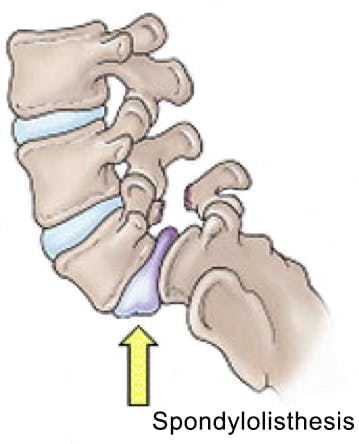
What is Spondylolisthesis?
Spondylolisthesis is a condition in which one of the bones of the back (vertebra) slips forward over the bone below it. Spondylolisthesis is a progression of spondylolysis. When the bones weaken to the point where the spine cannot maintain its correct position, the bones of the back may start to shift out of place. This usually occurs towards the base of the spine at the 5th lumbar vertebrae.
What causes Spondylolisthesis?
There are several small bones in the back that come together to form joints that keep the spine aligned, while still allowing movement. Spondylolisthesis is caused by a problem in one or more of the small joints that results in a bone shifting out of place. This can be caused by a number of different problems including:
- A congenital defect of the joints
- joint damage occurring from an accident or trauma to the spine
- A stress fracture in the vertebrae
- Joint damage due to an infection or arthritis
Spondylolisthesis is more common among children and teens who are participating in very physical sports, which place repeated forces on the spine (i.e., football, gymnastics, and weightlifting).
Signs and Symptoms
Spondylolisthesis may be present without any symptoms, but the most common symptoms are stiffness and increased low back pain. If too much slippage occurs, spondylolisthesis may cause pain and weakness in the buttocks and legs and muscle spasms that stiffen the back and tighten the hamstring muscles. Symptoms often appear during the teenage growth spurt and may worsen with bending or twisting.
Treatment Options
If spondylolisthesis is suspected, the most reliable method of diagnosis is an x-ray of the lumbar spine, which will determine whether the vertebrae are changing position. If diagnosed with spondylolisthesis, your orthopedist will then determine the best course of action. Treatment begins with stopping any aggravating activities such as heavy lifting, twisting, or high physical activity causing stress to the lumbar spine. Depending on the severity of the condition, a back brace may be indicated for a period of time to prevent hyperextension (backward bending) of the spine. Initial management is conservative and involves stretches and strengthening exercises for the back and abdominals. Your physical therapist will perform a thorough evaluation and develop an individualized treatment plan with specific stretches and exercises to make your trunk stronger and movement easier.
Your physical therapist will give you specific guidelines for your child's individual needs.
